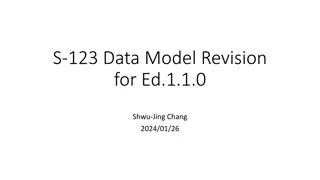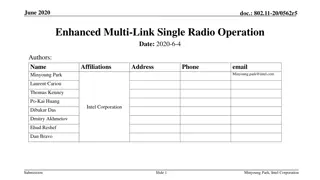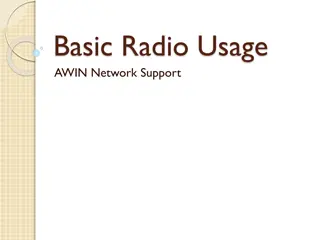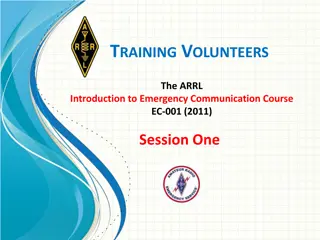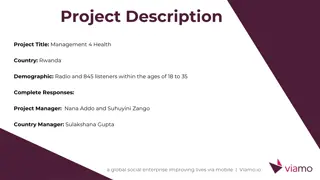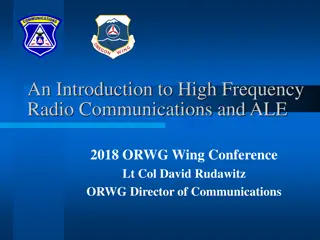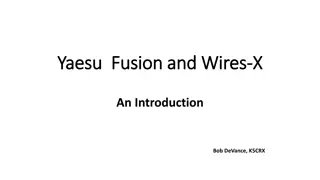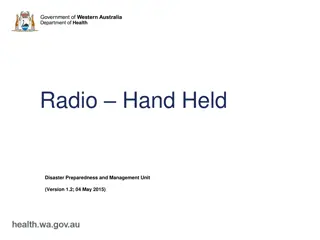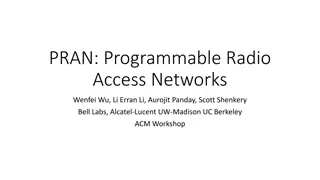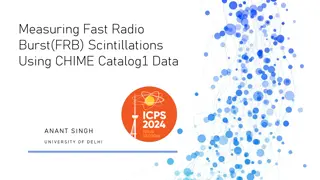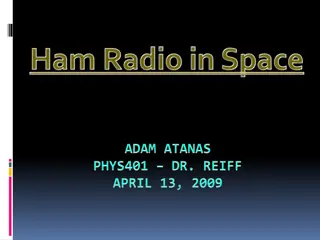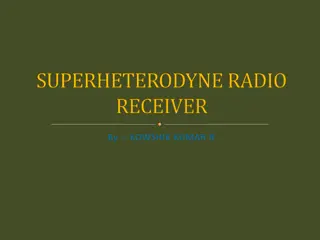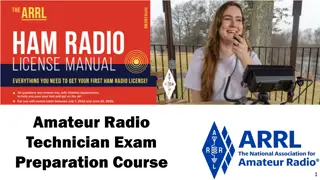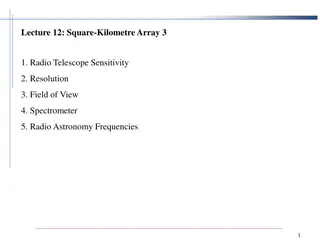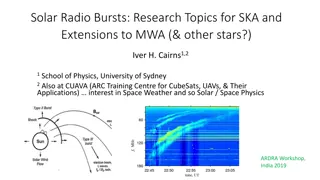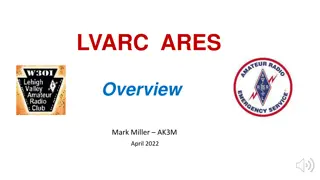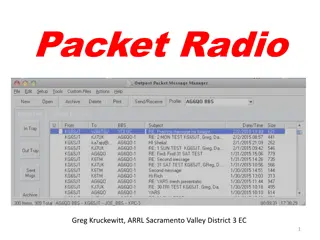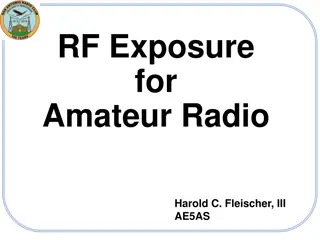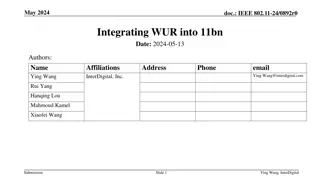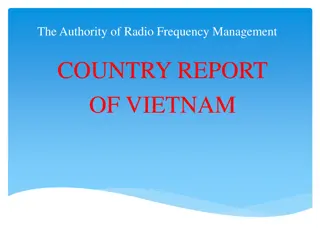Understanding Software-Defined Radio (SDR) with GNU Radio Introduction
Software-defined radio (SDR) revolutionizes radio technology by enabling flexible software-based solutions that can alter transmitter parameters without hardware changes. The SDR tiers defined by the SDR Forum provide evolving capabilities in terms of flexibility, transitioning from hardware-control
5 views • 54 slides
Update Summary of S-123 Data Model Revision and Major Changes
This document outlines the revisions and major changes in the S-123 Data Model, including the addition and remodeling of feature types, information types, and data models to support remote control and connectivity. It also details the removal and addition of attributes and the restructuring of compl
5 views • 23 slides
Exploring GNU Software Radio: A Comprehensive Overview
Delve into the world of GNU Software Radio with Thanh Le and Lanchao Liu as they discuss the hardware, software, and communication aspects of this technology. Learn about USRP solutions, hardware capabilities, available daughter-boards, and explore the software-defined radio user applications. The b
4 views • 43 slides
Understanding Radio Wave Propagation and Solar Activity Effects
Explore how radio waves travel and are influenced by solar activity. Learn about HF radio wave propagation, critical layers, day-night cycle effects, sunspots, coronal mass ejections, solar wind, auroras, and more. Discover the impacts of solar flux, sunspot numbers, and solar flares on radio wave c
7 views • 45 slides
Enhanced Multi-Link Single Radio Operation Proposal
The proposal discusses an enhanced mode of operation for single radio non-AP MLDs to enable multi-link operation, improving throughput and reducing latency. It addresses challenges in busy network environments, aiming to achieve low latency benefits similar to concurrent dual radio setups. The propo
0 views • 22 slides
Understanding Trunking vs Conventional Radio Systems in AWIN Network Support
Arkansas Wireless Information Network (AWIN) is a statewide digital trunked communications system utilizing APCO Project 25 standard. AWIN facilitates reliable communication for first responders with over 100 tower sites and 27,000 radios. Trunking enables efficient sharing of communication paths am
0 views • 32 slides
Understanding AWIN Network and Radio Communication Basics
Learn about the AWIN network, P25 standard, radio terminology, and why radios are crucial for first responders. Discover the significance of AWIN in providing reliable statewide communication and the role of radios in saving lives. Explore the basics of radio usage, etiquette, and the electromagneti
0 views • 31 slides
Understanding Emergency Communication Systems for Volunteer Training
This content covers various topics related to emergency communication systems for volunteer training, including agency communication systems, government radio systems for police and fire departments, emergency medical radio systems, American Red Cross frequencies, and types of served-agency radio sy
2 views • 29 slides
Understanding Radio Wave Propagation in the Ionosphere
Radio wave propagation in the ionosphere is influenced by factors such as the radio refractive index and absorption of radio wave energy. This chapter delves into the interaction of radio waves with the ionosphere, discussing concepts like the electromagnetic spectrum nomenclature and the frequency
0 views • 15 slides
Health Management Through Mobile Radio Surveys in Rwanda
A global social enterprise, Viamo, is conducting mobile radio surveys in Rwanda to improve health management. The surveys target 18-35-year-old radio listeners. The analysis of demographic data, complete responses, gender breakdown, and knowledge of the advert reveal valuable insights for enhancing
0 views • 44 slides
Understanding High Frequency Radio Communications and ALE
High Frequency (HF) radio communications, specifically using Single Side Band (SSB) modulation, are essential for effective long-distance communication. The components of an HF radio system include a transceiver, antenna, and power source. By utilizing the ionosphere, HF/SSB modulation enables cost-
5 views • 47 slides
Understanding Yaesu Fusion and WIRES-X Communication Systems
Yaesu Fusion and WIRES-X are digital communication systems for voice, data, and picture transfer in amateur radio. Fusion uses C4FM FDMA modulation, while WIRES-X extends communication globally via the internet. Various equipment like mobile radios, repeaters, and hotspots support these systems, ena
0 views • 20 slides
Co-Evolution of Galaxies and AGN with Next-Gen Radio Surveys: Insights and Prospects
Understanding the co-evolution of galaxies and active galactic nuclei (AGN) through next-generation radio surveys is crucial for advancing astrophysical knowledge. These surveys offer a comprehensive view of star formation, AGN activity, and AGN feedback mechanisms. The quest for multi-band informat
0 views • 18 slides
Understanding Weak Signal Propagation in Radio Waves
This informative content delves into weak signal propagation and its various aspects related to electromagnetic waves, particularly in the context of radio communication. It covers topics such as radio waves, radio horizon, knife-edge diffraction, tropospheric scatter mode, auroral reflection, and m
1 views • 37 slides
Understanding Radio Wave Propagation for Amateur Radio Technicians
Discusses the various ways radio waves propagate based on frequency and environmental characteristics, including line of sight, ground wave, and sky wave. Explains how radio energy travels in a straight line, follows the Earth's surface, reflects, refracts, and diffracts. Covers multipath interferen
0 views • 120 slides
Amateur Radio Technician Exam Preparation Overview
Dive into the world of Amateur Radio Technician Exam Preparation with a focus on licensing regulations, types and classes of licenses, sample licenses, exam procedures, and more. Learn about the FCC's rules for the amateur radio service, licensing terms, the different classes of licenses available,
1 views • 51 slides
Understanding Packet Radio: A Comprehensive Guide
Packet radio, utilizing VHF FM technology, is a digital mode allowing keyboard-to-keyboard communication, messaging, mailboxes, bulletins, and more. It uses the AX.25 protocol and operates at varying data rates on VHF and HF bands. The system comprises basic stations and automated nodes, each requir
0 views • 20 slides
Dispatch Radio 2021: Updates, Operations, and Why Radio Matters
Discover the latest updates and operations of Dispatch Radio in 2021, including digital repeaters, radio consoles, and extended attack equipment. Explore the importance of using radios for communication and the unique benefits they offer in various scenarios. Concluding with contact details for ques
0 views • 8 slides
Insights into Radio and X-ray Emission in Radio-Quiet Quasars
Radio galaxies are categorized as radio-loud or radio-quiet based on the presence of jets and lobes. Unlike radio-loud quasars, the nuclear radio emission in radio-quiet quasars does not originate from large-scale jets. Possible explanations include broad absorption lines, magnetically accelerated e
0 views • 15 slides
Radio Hand Held Disaster Preparedness and Management Unit
The Radio Hand Held Disaster Preparedness and Management Unit is a Motorola DP4601 digital radio designed for emergency communication. It features UHF frequency band, 1000 channel capacity, long battery life, GPS, and emergency button. Learn how to operate this radio safely and efficiently for disas
0 views • 15 slides
Spectrum Topics for WRC-19: Protection of Radio Altimeter and WAIC Systems
The document discusses the importance of protecting radio altimeter systems from potential interference due to future WRC decisions, focusing on Wireless Avionics Intra-Communications (WAIC) coexistence. It emphasizes the critical role of radio altimeters in aviation safety and ongoing efforts to en
0 views • 9 slides
Overview of GRANDproto Project Workshop on Autonomous Radio Detection
GRANDproto project workshop held in May 2017 focused on improving autonomous radio detection efficiency for the detection of extensive air showers (EAS). Issues such as detector stability and background rates were discussed, with the goal of establishing radio detection as a reliable method for EAS
1 views • 14 slides
Engaging Key Actors in Climate Information Value Chain Through Radio Discussions
In this discussion, the importance of engaging key actors along the climate information value chain through radio discussions is emphasized. The symbiotic relationship between radio journalists and meteorological authorities is highlighted, as well as the key actors involved such as Government Agenc
0 views • 22 slides
Evolution of Software Defined Radio Systems
Software Defined Radio (SDR) revolutionizes radio communication by implementing traditional hardware components using software on a personal computer. With SDR, modulation techniques, security functions, and waveform requirements can be controlled through software, enabling flexibility and adaptabil
0 views • 20 slides
Revolutionizing Radio Access Networks with PRAN: A Game-Changer in Network Technology
PRAN (Programmable Radio Access Networks) introduces a transformative approach to overcome challenges in current RAN architecture, offering programmability, resource coordination, and increased infrastructure utilization. By centralizing base station processing, PRAN optimizes radio resource allocat
0 views • 30 slides
Exploring Fast Radio Bursts (FRBs) and Scintillations in the Universe
Fast Radio Bursts (FRBs) are millisecond-duration bursts of radio waves originating from outside our galaxy, offering researchers a unique opportunity to investigate baryon distributions and probe the cold gas clumps in the Universe. Scintillations in radio waves caused by irregularities in the inte
1 views • 25 slides
The Impact of Ham Radio in Space Exploration
Ham radio has played a crucial role in space exploration, from its first use by Owen Garriott in 1983 to its integration into the International Space Station (ISS) through organizations like ARISS. This technology has enabled communication between astronauts and amateur radio operators on Earth, fos
0 views • 13 slides
Introduction to Superheterodyne Radio Receiver Circuits
Superheterodyne radio receiver circuits operate based on heterodyne or frequency mixing principles. These circuits involve using a local oscillator to mix the incoming signal with a sine wave, shifting it to an intermediate frequency (IF) for further processing and demodulation. The design includes
0 views • 16 slides
Understanding Radio Communication Essentials for Amateur Radio Technician Exam
Dive into the fundamentals of radio communication for the Amateur Radio Technician Exam. Explore topics such as modulation, equipment, transmission, reception, and the art of adding and extracting information from radio waves. Gain insights into how information is converted, transmitted, and receive
0 views • 105 slides
Radio Australia International Services Overview
Radio Australia, presented by Gary Baxter, is managed by ABC Communications Networks Division and provides both domestic and international services. It offers shortwave transmissions in multiple languages targeting remote areas in Australia and the Pacific region. Additionally, Radio Australia colla
0 views • 12 slides
Understanding Radio Telescope Sensitivity and Resolution in Radio Astronomy
This lecture covers the concepts of radio telescope sensitivity in detecting small temperature variations from the sky, including factors such as radiometric sensitivity, antenna noise temperature, receiver system noise, and more. Additionally, it touches upon the resolution capabilities of radio te
0 views • 22 slides
Solar Radio Bursts: Research Topics for SKA and MWA
Research on solar radio bursts, particularly Type II and III bursts and Coronal Mass Ejections (CMEs), explores dynamic solar activity, fundamental physics, and their impact on space weather. Topics include density profiles, source regions, polarization, and weak radio emissions associated with CMEs
0 views • 19 slides
The Jansky VLA Sky Survey (VLASS) Technical Plan and Status Summary
The Jansky VLA Sky Survey (VLASS) is a comprehensive project aimed at capturing unique snapshots of the radio sky through various radio studies and imaging techniques. The survey covers a wide range of frequencies and configurations, enabling detailed exploration of the radio universe. With a focus
0 views • 10 slides
Cognitive Radio Network and Game Theory Exploration at University of Houston
Explore the application of cooperative game theory in cognitive radio networks, focusing on spectrum sensing, dynamic spectrum access, and coalitional games. Detailed overview of research conducted at the Department of Electrical and Computer Engineering, University of Houston. Learn about cognitive
0 views • 42 slides
ARES Overview: Supporting Local Events with Amateur Radio
ARES, the Amateur Radio Emergency Service, supports local events by providing crucial communications support. Volunteers help with traffic handling, emergency reporting, and ensuring smooth event operations. This presentation covers what ARES is, how it functions, volunteer expectations, the importa
0 views • 13 slides
Understanding the Basics of Packet Radio for Amateur Communication
Explore the world of packet radio, a digital mode used by amateur radio operators to build wireless computer networks. Learn about its benefits, how it works using the AX.25 protocol, making connections, advantages such as error checking, and building a packet station with the necessary components.
0 views • 19 slides
RF Exposure for Amateur Radio: Understanding Sources and Safety Measures
Exploring the various sources of RF exposure in relation to amateur radio, this comprehensive guide by Harold C. Fleischer, III AE5AS sheds light on different antennas like those used by AM, FM radio stations, TV stations, MW telecommunications, police, taxis, and even Wi-Fi routers. Each image show
0 views • 39 slides
Garmin Vivosport Tracker: Smart GPS Fitness Bracelet
The Garmin Vivosport tracker is a smart GPS fitness bracelet packed with features to motivate you to stay active. With integrated GPS for precise outdoor activity tracking, it offers a wide range of indoor and outdoor monitoring capabilities. Once paired with your smartphone, you can access smart fe
0 views • 6 slides
Integrating WUR into IEEE 802.11bn for Enhanced Network Efficiency
IEEE 802.11-24/0892r0 proposes integrating Wake-Up Radio (WUR) technology into 11bn networks to improve reliability, support low latency traffic, increase peak throughput, and enhance power-saving capabilities. The WUR acts as a companion radio to the main connectivity radio, enabling power-saving w
0 views • 10 slides
Radio Frequency Management in Vietnam: Overview and Statistics
The Authority of Radio Frequency Management in Vietnam oversees a range of services including telecommunications, broadcasting, navigation, and aviation. With a detailed spectrum planning and assignment structure, the country holds numerous radio licenses and monitoring infrastructure to ensure effi
0 views • 14 slides

